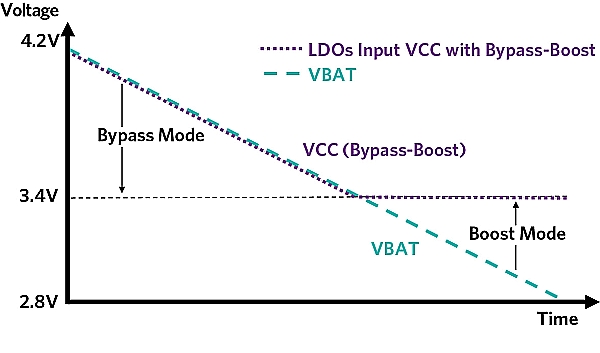A popular power source for portable devices is a single lithium-ion cell with 4.2V at full charge and 2.8V at end of discharge. However, some functions within portable electronics, such as a SIM card and DSP, require 2.8V and 3.3V. These are normally provided by low noise LDOs. The LDOs inputs (VCC) must be at a slightly higher voltage than the highest LDO output. Hence, VCC ends up right in the middle of the lithium-ion battery’s range of operation. The use of a step-up/down voltage regulator, capable of operating from an input that can be higher or lower than the output, becomes necessary. Figure 1 shows the battery voltage (VBAT) as the power source for a typical portable design.
In portable applications the voltage regulator efficiency is of the utmost importance, since higher efficiency translates into longer untethered operation. In this article we will review the available options, compare their performance, and determine the most efficient solution.
One way to solve the problem is to use a bypass-boost converter, namely a boost converter with an extra “pass” transistor integrated between the power source, VBAT, and the LDO input, VCC. Figure 2 shows the bypass-boost power train architecture and its operation table. Here the bypass transistor T3 accomplishes a “poor man’s” step-down operation.
This architecture can only regulate VBAT voltages lower than the set VCC = 3.4V. For VBAT > 3.4V the boost converter stops regulating and the pass transistor turns on, directly connecting VBAT to VCC. Figure 3 shows the battery profile discharging over time and the LDO input voltage for the bypass-boost architecture.For the majority of the time (VBAT > 3.4V) the pass transistor in the bypass-boost architecture literally “passes the buck” to the LDOs downstream. The LDOs bear the task of regulating the high VBAT value down to their output set values. Since this regulation is linear the result is high power dissipation inside the LDO. This results in greater energy consumption and also requires a board design and IC selection capable of dissipating this energy.
For more detail: Choose the right step-up/down voltage regulator for portable applications

